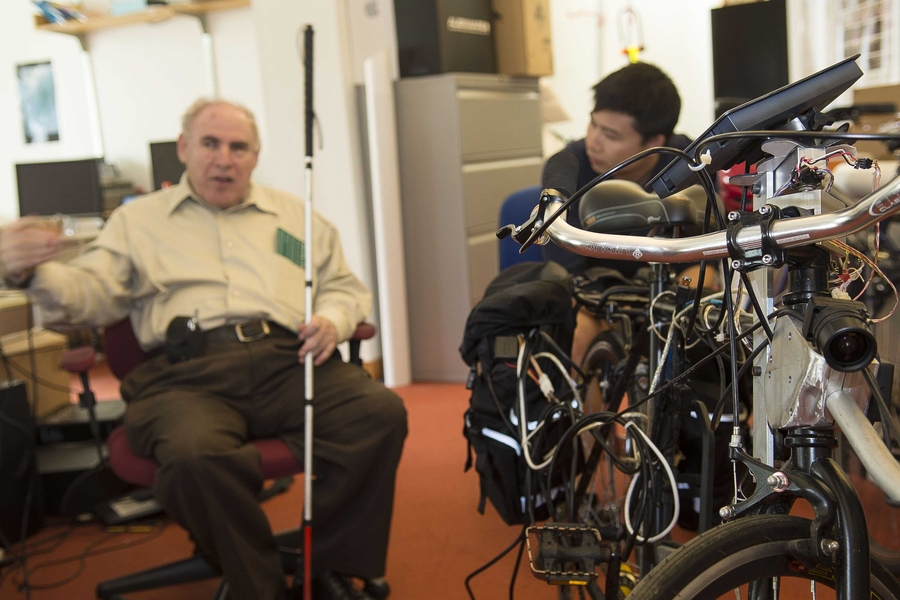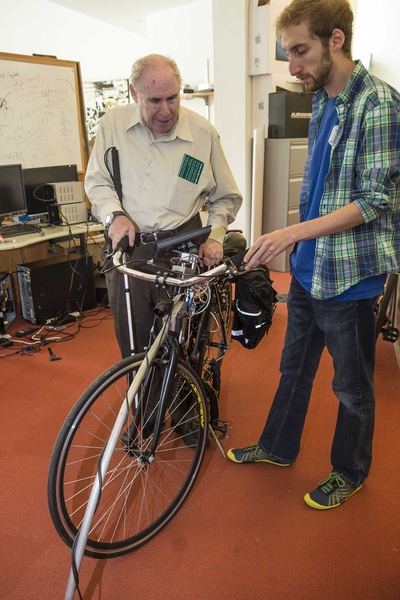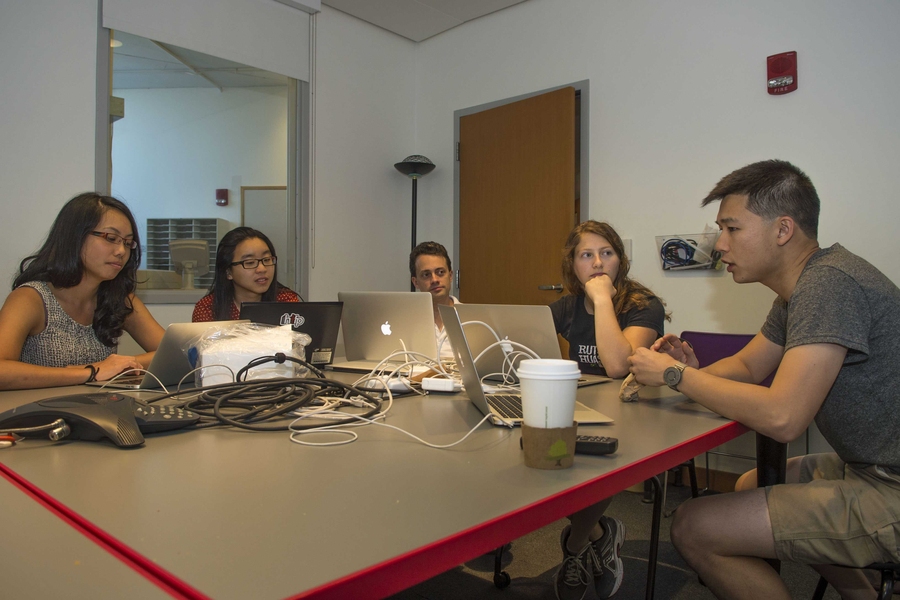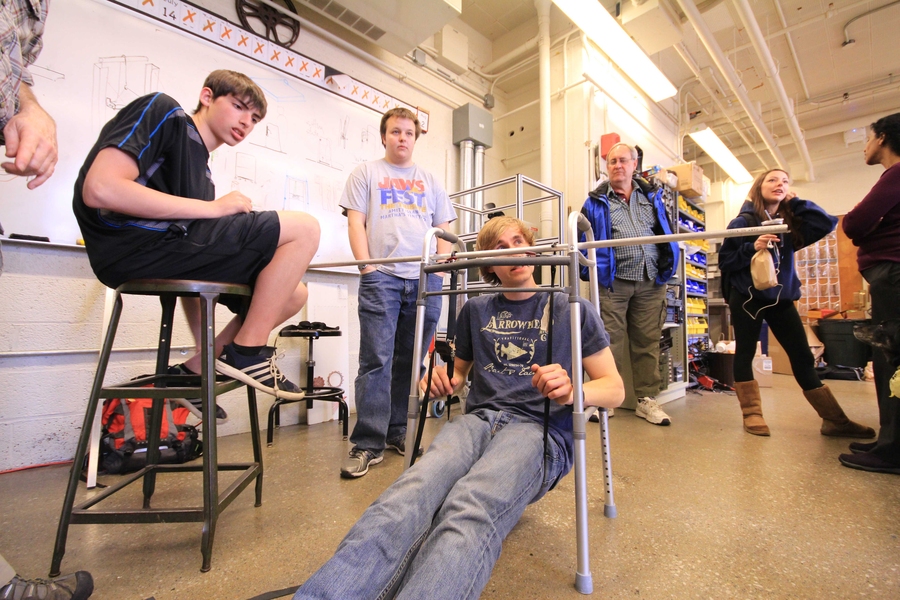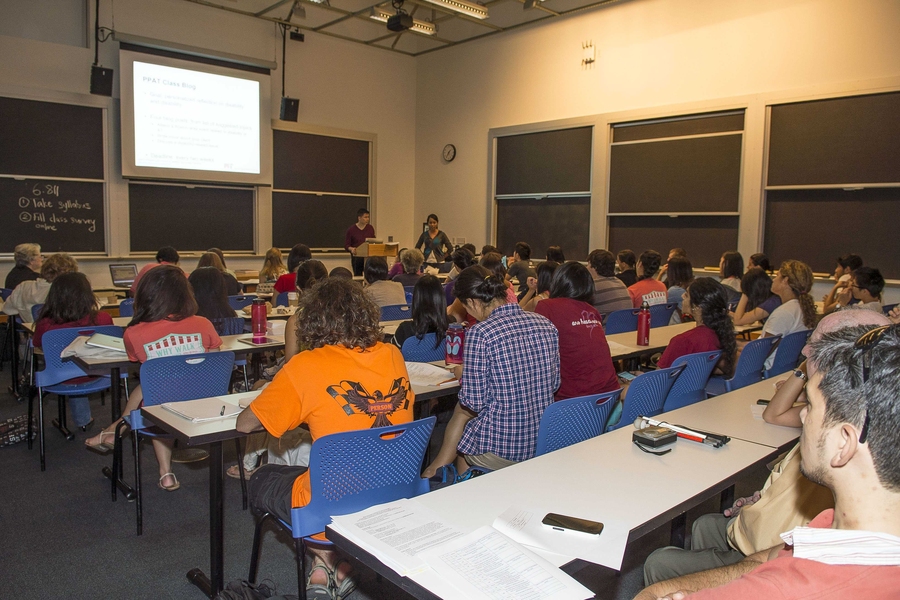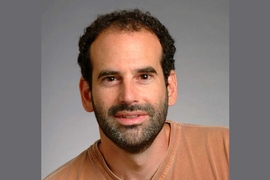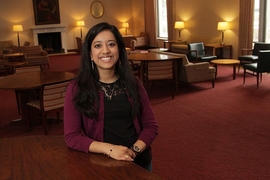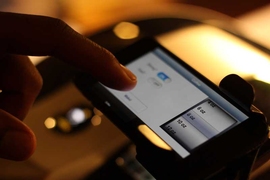The late professor Seth Teller created 6.811 (Principles and Practices in Assistive Technologies, or PPAT) in the fall of 2011. Through his extensive experience developing assistive technologies (AT) at MIT, his compassion for making technology available to all, and his innovative approach and drive to build this class, student interest in PPAT and AT has grown steadily since.
Following Teller’s untimely death on July 1 this year, a group of former PPAT and AT students including his graduate student William Li SM '12, who TA’d the inaugural PPAT offering; Grace Teo PhD '14, a former student and member of the MIT Assistive Technology Club; and a core group of students who took the class in 2013 have formed a team to continue Teller’s legacy through both the coninuation of PPAT and an outgrowth known as "AT Hack," a one-day workshop launched in spring 2014. Li and Teo, who will co-instruct this year's class, and three other members of the team will work with Professor Rob Miller, MIT MacVicar Faculty Fellow, member of the Computer Science and Artificial Intelligence Lab (CSAIL), and co-education officer of the Department of Electrocal Engineering and Computer Science (EECS).
Every year since the inaugural offering of PPAT, Miller had worked with Teller to help develop and teach the course. This was a natural fit since Miller’s research group, the User Interface Design Group, has been involved in assistive technology work.
Miller says about the class: “Unlike other design classes, which tend to focus on a market need — which is, very often, a need that the students themselves have — PPAT really pushes students out of their usual comfort zone, and drives them to understand another person’s problems and design solutions for them.” He adds, “That’s an incredibly valuable educational experience.”
Need-based design fits well with learning experience
Teller’s understanding of the unique challenges of creating novel, practical assistive technologies fed directly into the organization of PPAT. Given the highly specific needs and diversity of interests that people with disabilities have, there is almost an endless demand for assistive technology projects in the community. PPAT was designed to provide the structure to allow student teams to work with clients while learning underlying principles related to design, disability, and AT development through multiple prototype iterations of their work.
Li notes that one of the more subtle but profound innovations to PPAT’s setup is a written agreement signed by each team and client at the start of their project to set expectations and accept associated uncertainties in reaching the best solution. The students pledge to listen carefully and understand the client’s context and reality, communicate frequently and openly, and work hard to develop a lasting solution. Clients likewise pledge to provide feedback, try different iterations of the design, and acknowledge that the final product might not yield a successful assistive device. The most meaningful end result is a working partnership between students and client — often a mutually beneficial learning experience.
One of Li’s most vivid memories of his work with Teller was with the campus accessibility lab, for which manual wheelchairs were rented. Using the wheelchairs, students could move around campus, performing activities and visiting spaces to better understand the challenges that a wheelchair user might face. “He drove the wheelchair and tested the limits of its speed and maneuverability and was vocally frustrated by inaccessible features of campus — out-of-door automatic doors, dangerous uneven outdoor surfaces, and improper signage,” Li notes. In their follow-up discussion, Li and Teller decided to file dozens of MIT Facilities requests. “As with so many other things, Seth took on this task with excitement and vigor, a dissatisfaction for the status quo, and a desire to make things better.”
Grace Teo was so inspired by her experiences with assistive technologies, that she founded and co-chairs Open Style Lab, an educational 10-week summer program at MIT teaming student designers, engineers, and occupational therapists to create clothing for people with disabilities. Teo gained advice from Teller both in selecting clients for Open Style Lab and in managing client relationships and projects.
Spawnsing AT Hack and new clients
Now in its fourth offering, 6.811 has attracted more than 50 pre-registrants. Li and Teo have advertised the class as a good fit for students interested in public service, user-centered product design, working closely with a client with a disability (potentially in consultation with their caregivers and/or clinicians), and tackling difficult, real-world problems. They will be aided by PPAT teaching assistant Michelle Chen ’14, SM ’15 and lab assistants Ishwarya Ananthabhotla ’15, and Abigail Klein ’14, SM ’15.
Clients for PPAT are often drawn from centers in the Cambridge and Boston area such as The Boston Home, a specialized-care residence for about 100 adults with multiple sclerosis (MS) and other progressive neurological conditions; the Leonard Florence Center for Living, which offers high-tech care assistance to people with Lou Gehrig’s disease (ALS) and MS; the Carroll Center for the Blind and people affiliated with Perkins School for the Blind; and the Braintree Rehabilitation Center in Newton. In addition, clients from the MIT community including staff and students have come to value the specialized attention that the PPAT students provide. All of these sources have been established over the years as Teller continued to develop PPAT.
Another by-product of the class is the AT Hack, which was created by several PPAT students in spring 2014 as an intense one-day hackathon to provide an extension of the fall PPAT class. Ananthabhotla and Klein, along with Jaya Narain ’14, Jason Yang ’15, and Sresht Rengesh ’15, organized the first AT Hack through financial support from the MIT Public Service Center, the MIT Baker Foundation, and other sources. The event allowed two teams of 3-4 students each to work intensively with their clients on AT projects — including QR code readers for medicine bottles, auditory application to guide blind users at train stations, and "smart walkers" to help a client with dystrophied legs stand again after a fall. With continued support, Ananthabhotla and members of the original team are planning to offer an expanded version of AT Hack in spring, 2015. She notes about AT Hack, “Getting a chance to work on projects tailored to meet client needs across the spectrum of disabilities and engineering disciplines showed us how rewarding working with AT could be.”
Assisting the legacy of assistive technologies at MIT
Assistive technologies continue to find a home at MIT in the 3rd floor CSAIL laboratory that Seth Teller established with his group, the Robotics, Vision, and Sensor Networks Group, when they settled into the Stata Center in 2004. Now, numerous assistive technology projects created via PPAT, and other sources including the Assistive Technology Club established in 2010, are under continued development in an environment that has been extremely conducive to creative examination and discovery.
Recently, Jeffrey Drucker, a client who is blind, shared his articulate reactions to a number of AT projects including the blicycle, a project developed in PPAT in 2011 by Steve Levine, currently an EECS graduate student, and Emily Obert. A combination of electrical and mechanical technologies and software were engineered to outfit an off-the-counter bicycle to allow a person who is blind to do what seems unthinkable: ride it independently!
Levine describes the blicycle’s features: Custom vibrating handlebars signal the rider in what direction and how hard to turn. Sensors including a camera that tracks location and lidar to scan for potential obstacles send data to an onboard computer. The team’s software then signals the direction for the rider to turn via the vibrating handlebars.
The blicycle, which has been tested on indoor running tracks, was initially conceived when a client approached Teller in 2010 to fulfill a dream of once more riding a bicycle. He also wanted to gain a new way to exercise — something, for which, he explained, people who are vision-impaired have few options.
Other students including Ryan Fish ’15 have worked on this project. Recently two visiting students from Italy — Simone Fontanesi and Alessandro Frigerio with the support of the Andrea Bocelli Project — have even incorporated some of the technologies used for the blicycle in a new system to detect pedestrian crossing lines that gives feedback to a user regarding his/her position within the lines. They hope this work can be useful to other projects that arise in PPAT. Inspired by working with the PPAT group and other AT students during their 10-week research visit, Fontanesi and Frigerio were particularly grateful to speak at length with Drucker, who described in detail how he navigates public transportation and walkways to get to a destination such as the Stata Center at MIT.
Drucker’s meeting also included discussion on a related project, the Safety Mobility and Navigation system under development by PhD student Rahul Namdev and postdoctoral associate Nick Wang. The goal of this technology is to develop wearable platforms to convey live, real-time environmental information to help blind users navigate efficiently and safely without using other assistive tools such as a cane or an assistance animal. This project will ultimately provide information about safe walking regions, hazardous drop-offs, and variables such as ascents, descents, trip hazards, etc., appearing in the path of the visually impaired user.
If the continuing deep interest on the part of MIT students in assistive technologies is any indication, the foundations that Seth Teller laid in this field will inspire new generations of AT hackers and PPAT students to partner with new clients and build new life-asserting functionality into their daily lives. And the value of assistive technology, Miller notes, is not necessarily limited to a segment of humanity.
“The fact that PPAT projects also do good in the world, helping people who are otherwise underserved by high tech, is like icing on the cake — not icing, really, but another whole layer of the cake," Miller says. "All of us, unless we’re very, very fortunate, will experience a disability at some point in our lives — whether from illness, accident, or just the ordinary process of aging. I think we should all feel lucky that a generation of MIT students are being challenged to think about, care about, and work on assistive technology.”
